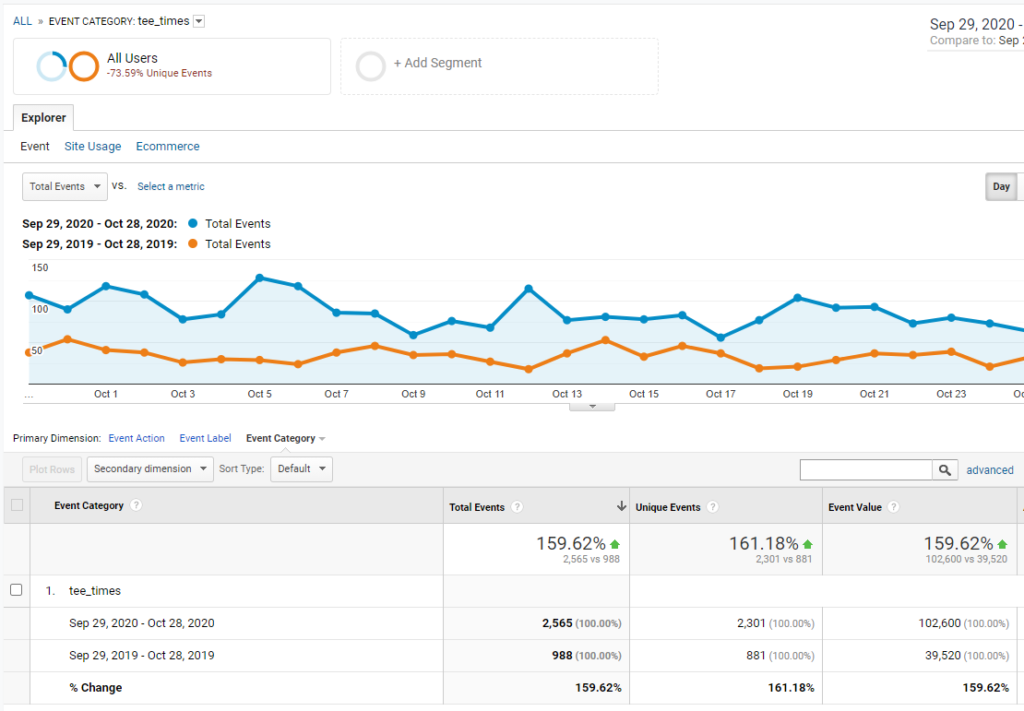Online 3rd party tee time distributors are good at golf course SEO. Search nearly any public golf course and you will consistently see golfnow.com, teeoff.com, and supremegolf.com which are three of the largest aggregators of online tee times.
With the announcement of the new PGA Tour Marketplace my guess is in 2021 you will start to see their platform as well. What you will not see is the consistent search result for individual golf course websites.
To be clear, third parties are NOT good at improving your golf course’s website SEO, although they certainly are capable, they simply don’t have the incentive.
The marketing tactics used by these third parties are to drive traffic to their websites where they can liquidate trade times, collect big convenience fees, collect big credit fees, and in some instances receive commissions.
Even if a consumer searches for your golf course by name most likely they will see these aggregate sites first.
I searched the club below directly by name and was served an ad for the 3rd party website.

This is topic for another day but, it’s part of the proof that getting your website to show when potential customers are looking for golf courses to play online is increasing in difficulty.
So how do we take our traffic back and compete online for eyeballs? First a little education.
What is SEO?
SEO stands for Search Engine Optimization, which is the practice of increasing the quantity and quality of traffic to your website through organic search engine results.
How can improved SEO help my golf course?
With organic search being the primary source of website traffic, the main benefit of improved golf course SEO is that it will increase your visibility to potential customers.
- Increased website visibility leads to more website visits.
- More website visits leads to more direct sales.
- More direct sales means better margins.
- Better margins means more revenue for your golf course.
What are the some ways we could help improve your golf course SEO?
For most golf courses coming off a large 3rd party website provider, there is some low hanging fruit we would address first. Mainly page title / title tag optimization and ensuring the keywords we are trying to rank for occur in specific locations on the page.
From there, we can get a bit more technical and start “marking up” the content to make it easier for search engines to know what the page content.
There are other factors to consider as well, such as the user experience. For instance, how fast does the website page load and improving the relevance of the content. If users consistently click on your search result, the page loads slowly and the content isn’t relevant to their search, search engines will start to take notice and rank the site lower in their index.
Improving SEO won’t happen overnight but, over time with the right setup, better golf course SEO can be achieved. If you want quick results that are sure to get your golf course to the top of the search results, that’s where a search engine marketing campaign comes into play.
Golf course SEO - real world results
The results below are from a club located in the Southeast US. This club does not typically see high a volume of users on their website when compared to some other clubs and I chose this club as it’s more in line with the average increases a golf course can expect from a better SEO campaign.
In 2019, this club’s website was managed by a large 3rd party in the golf industry and GolfBack took on the management of the website in April 2020.
Here are results from a 30 day period about 6 months after the website transition.
Google search engine impressions and clicks. - Organic Traffic from Search
- Total Clicks – For most result types, any click on a search result that sends the user to a page outside of Google Search is counted as a click, and clicking a link that stays inside search results is not counted as a click. Clicking a search result to an outside page, returning, then clicking the same link again counts as only one click.
- Total Impressions – The total times the course was shown in the search results for any given keyword. If your course ranks for the term “bunker” and shows on page 5 of the results, that will be counted as an impression.
- Average CTR – The average “click through rate” meaning the average your website was shown in the search results vs. how many times a user clicked the link.
- Average Position – The average ranking in the search results for your website. There are typically 9 spots per page for each search query (sometimes less). This is the average for every keyword your website ranks for in a search. So again, if you rank for “bunker” but it’s not very relevant to the user, your golf course website may be shown on page 9 of the results, or 88th position.

Google Search results from 9/29/2019 – 10/28/2019

Google Search results from 9/29/2020 – 10/28/2020
While the total number of impressions dropped YoY by 1,900 – the click through rate has nearly doubled while the Average CTR increased by 100%. This is related to the average position of all keyword searches showing improvement.
Website total visits
The following shows how better golf course SEO tactics increased the total visitors and how what channels users used to find the club’s website.
The report defines the following:
- Organic Search: The user has entered the site from an internet search
- Direct: The user has entered the site from directly entering the URL in their browser
- Referral: The user has entered the site from another website that links to your site
- Email: The user has entered the site directly from an email campaign
- Social: The user has entered the site directly from a social media website

As the report shows, every channel has seen growth YoY and has resulted in a 41.17% increase in total users over a 30 day period.
The interesting part - AKA the impact on revenue
Driving more people to your website has multiple benefits including spreading information on your current event or banquet offering to more people signing up for your newsletter. But, a golf course typically has one main goal… that is to sell rounds of golf.
On our golf course websites, we track conversions to know when people are booking tee times as a result of visiting the website. The report below shows the same time period of YoY, 9/29 – 10/28 but take note of the increase of tee times being sold.

Here is a closer look

Although this club only had a 41% increase in total website visits as a result of better SEO, the number of tee times sold through the booking engine increased by 161% and the value for those tee times went from $39,520 to $102,600. A 159% increase!
This is before we installed the direct drive booking engine at this club which will improve website traffic even further. Check out the article that reveals those stats here.
Closing words
Putting your website to work for your business is the first step to better digital marketing and improving SEO is just part of the equation. It’s a little cliché, but your website is really an employee. If you hired an employee to produce results, and they consistently let you down you would be quickly reconsidering their employment within your organization.
Here are some questions you should be asking of your website and if it’s falling short of these responsibilities, then maybe it’s time to change.
- Does my website provide quality lead generation?
- Does my website provide my user’s with a quality experience?
- Does my website collect customer data and automatically update my marketing software?
- Does my website track conversions?
- Does my website show up on the first page for search results other than when people search my course directly by name?



